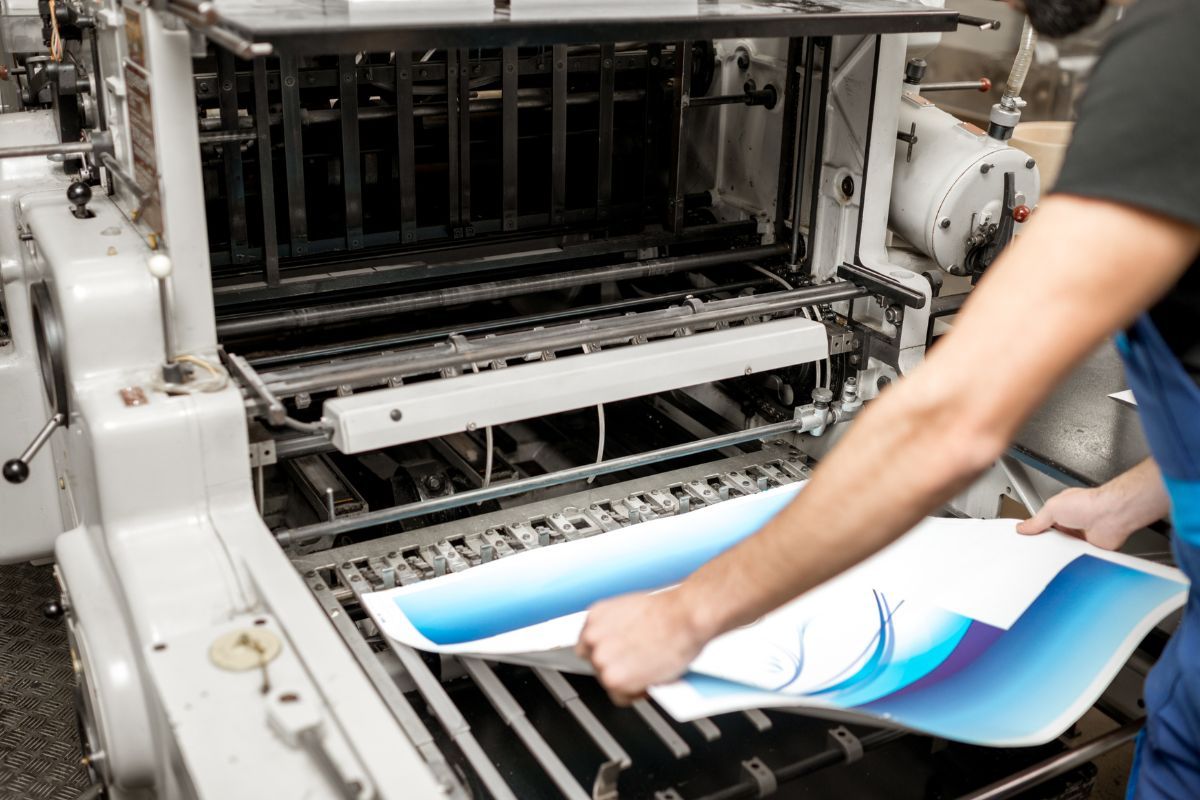Digital printing is a method that involves producing images directly from a digital file onto various materials, skipping the need for traditional printing plates.
This modern approach allows for quicker turnaround times and greater design flexibility than older printing methods.
You can print anything from promotional materials to custom products with ease.
Table of contents
- Understanding Digital Printing
- Comparing Printing Techniques
- Applications of Digital Printing
- Advantages of Digital Printing
- Digital Printing Media and Materials
- Digital Printing and Design
- Business Implications of Digital Printing
- Innovations and Trends in Digital Printing
- Environment and Sustainability
- Frequently Asked Questions
- How does digital printing work?
- What are the main uses of digital printing?
- How does digital printing differ from screen printing?
- What types of materials can be printed on using digital printing technology?
- Can digital printing be used on both paper and fabric?
- What advancements have been made in the history of digital printing?
One of the significant advantages of digital printing is its ability to produce high-quality prints at a lower cost for smaller runs. This means you can personalize items without the hefty expenses associated with traditional printing.
Understanding how digital printing works can help you make informed choices for your printing needs.
Whether you are a business owner looking to create marketing materials or an artist seeking to print your designs, digital printing offers a versatile solution.
It combines technology and creativity, making it an appealing option for various projects.
Understanding Digital Printing
Digital printing is a modern method that allows you to directly transfer images and designs onto a variety of surfaces. This technology eliminates the need for traditional printing plates, making it faster and simpler for many applications.
Fundamentals of Digital Printing Process
The digital printing process begins with a digital image, which can come from software or digital photographs.
This image is sent to a digital printer, which uses inkjet or laser technology to apply the image directly onto the substrate, like paper, fabric, or plastic.
In this method, you can produce high-quality prints with vibrant colors and fine details. The process is highly efficient, allowing for small production runs without the need for setup costs associated with traditional printing methods, such as screen printing.
Digital Printing Technologies
There are several technologies involved in digital printing. The most common include:
- Inkjet Printing: Uses tiny droplets of ink to create images. It’s popular for photo printing and on-demand production.
- Laser Printing: Utilizes a laser to transfer toner onto the surface, offering faster speeds and high-quality text printing.
- Digital Press: A large printing machine designed for professional outputs, providing high volume with consistent quality.
Each of these technologies has its strengths, making it essential to choose one based on your specific printing needs.
Inkjet vs. Laser Printers
When choosing between inkjet and laser printers, consider the following:
Inkjet Printers: Excellent for photography and detailed images. They can produce vibrant colors but may have slower print speeds. Ink costs can also add up over time.
Laser Printers: Best for printing text-heavy documents quickly. They tend to be more cost-effective for large volumes. The quality is sharp, but color prints may not be as vibrant as inkjet prints.
Both have their place in digital printing, depending on your requirements for quality and speed.
Digital Press and Production Print Technology
Digital presses are larger machines designed for commercial and high-volume printing. They combine the best features of inkjet and laser technologies.
These presses are capable of producing large quantities of printed materials efficiently. They can handle various substrates, allowing for flexibility in projects, from brochures to banners.
With advancements in digital printing technology, there is greater customization and quicker turnaround times, making digital presses a popular choice in the printing industry.
Comparing Printing Techniques
| Fabric | Why It’s Good for Digital Printing? | Best Uses | Best Printing Method | Recommended Printer Type |
|---|---|---|---|---|
| Cotton | Absorbs ink well, provides sharp prints, eco-friendly. | T-shirts, tote bags, home textiles. | Direct-to-Garment (DTG), Pigment Printing | DTG Printer (e.g., Epson SureColor F2100), Pigment Inkjet Printer |
| Polyester | Works well with sublimation, vibrant and durable prints. | Sportswear, activewear, banners. | Dye-Sublimation Printing | Sublimation Printer (e.g., Sawgrass SG1000, Epson F570) |
| Silk | Luxurious texture, deep color penetration, high detail. | Scarves, dresses, high-end fashion. | Reactive Dye Printing | Reactive Inkjet Printer (e.g., Mimaki TX300P) |
| Linen | Natural texture enhances unique, artistic prints. | Home décor, tablecloths, curtains. | Pigment Printing, Reactive Dye Printing | Pigment Inkjet Printer (e.g., Kornit Presto) |
| Rayon/Viscose | Soft, smooth surface absorbs ink well, bright colors. | Dresses, scarves, casual wear. | Pigment Printing, Reactive Dye Printing | Reactive Inkjet Printer or Pigment-Based Printer |
| Canvas | Thick material holds prints well, durable for artwork. | Home décor, paintings, tote bags. | Pigment Printing, UV Printing | Pigment-Based Printer (e.g., Canon PRO-2100), UV Flatbed Printer |
| Nylon | High durability, requires pre-treatment for best results. | Sportswear, umbrellas, outdoor gear. | Acid Dye Printing | Acid Dye Inkjet Printer (e.g., Epson Monna Lisa) |
| Blended Fabrics (Cotton-Polyester, etc.) | Combines benefits of both fabrics, balanced durability & softness. | Custom apparel, upholstery. | Hybrid Printing (DTG + Sublimation) | Hybrid DTG & Sublimation Printer (e.g., Brother GTX Pro) |
When exploring different printing techniques, it’s important to understand how various methods stack up against one another. This section breaks down key comparisons to help you choose the right technique for your needs.
Offset vs. Digital Printing
Offset printing is known for its high-quality output, especially for large volumes. It uses metal plates to transfer images, making the initial setup costly and time-consuming. This method works well for projects needing consistent quality, such as books and magazines.
On the other hand, digital printing uses a digital printing press that directly applies ink to the medium. It allows shorter print runs at a lower cost with faster turnaround times. While digital printing doesn’t always match the quality of offset, recent advancements have greatly improved its output.
Screen Printing and Contemporary Alternatives
Screen printing is another popular technique, particularly in custom apparel and promotional items. It involves forcing ink through a mesh screen, creating vibrant colors with high opacity. This method is ideal for large quantities of the same design but can be less efficient for smaller runs.
Contemporary alternatives, such as direct-to-garment (DTG) printing, leverage digital technology. DTG is suitable for complex designs with multiple colors, offering flexibility for small orders.
Each method has its specific use cases, depending on the project requirements.
Pros and Cons of Different Printing Methods
| Printing Method | Pros | Cons |
|---|---|---|
| Offset Printing | High quality, cost-effective for high volumes | High setup costs, longer turnaround |
| Digital Printing | Quick, ideal for small runs | Sometimes lower quality than offset |
| Screen Printing | Vibrant colors, great for bulk orders | Time-consuming for multi-color designs |
| Direct-to-Garment | Excellent for detailed designs, small amounts | Slower and may not work on all fabrics |
Each technique presents distinct advantages and limitations. Knowing these factors helps you make an informed decision based on your specific printing needs.
Applications of Digital Printing

Digital printing is widely used across various industries for its flexibility and efficiency. This method allows for personalized products and quick production, making it a popular choice for several applications.
Business and Marketing Material Printing
In business, digital printing plays a crucial role in creating impactful marketing materials. You can use it to produce business cards, flyers, and brochures that effectively represent your brand.
With digital printing, you can easily customize designs to match your company’s colors and themes. It also supports short runs, meaning you can print only what you need, reducing waste.
Many businesses appreciate the quick turnaround time, enabling them to respond to market changes swiftly. High-quality images and vibrant colors ensure that your printed materials stand out.
Custom Apparel and Fabric Printing
Custom apparel is another strong application of digital printing. You can print unique designs on fabrics, such as custom t-shirts or other clothing items, directly from digital files.
Digital printing allows for intricate designs and vibrant colors, making your apparel attractive and eye-catching. You have the option to personalize items for events, team sports, or promotional giveaways.
The ability to print on various fabrics, including cotton and performance materials, adds to the versatility. This method also ensures that the prints remain durable, even after multiple washes.
Decorative and Customized Product Printing
Digital printing is ideal for creating tailored decorative products. You can apply it to items like promotional products, wall art, or home décor.
Personalization is a key benefit in this area. You can choose unique images or text that resonate with your audience, making each piece special.
From custom mugs to printed canvases, digital printing allows for quick production and detailed designs. It’s perfect for businesses looking to offer one-of-a-kind gifts or branded merchandise.
Books, Magazines, and Publishing
In publishing, digital printing has transformed how books and magazines are produced. You can print small batches of books, making it easier for independent authors or niche publishers to enter the market.
With digital printing, you can easily adjust content without the need for extensive reprints. This flexibility is particularly useful for magazines, where content changes frequently.
High-quality printing is achievable for both text and images, ensuring a professional finish. This method is cost-effective for short runs, meaning you can print exactly what you need without financial strain.
Advantages of Digital Printing
| Factor | Digital Printing | Screen Printing | Offset Printing | Heat Transfer Printing |
|---|---|---|---|---|
| Setup Cost | Low – No need for screens or plates. | High – Requires screens for each color. | High – Requires printing plates. | Medium – Needs transfer paper or vinyl. |
| Production Time | Fast – Direct printing, no setup delay. | Slow – Needs time for screen preparation. | Slow – Plates must be created first. | Medium – Needs pressing and cooling time. |
| Customization | High – Easy to customize each print. | Low – Difficult to make changes. | Low – Designed for mass production, not customization. | Medium – Customizable but less detailed. |
| Small Batch Printing | Cost-effective – No extra setup costs. | Expensive – High cost for small batches. | Not suitable – Designed for large-volume printing. | Suitable but not as precise. |
| Detail & Resolution | Excellent – High-quality images with fine details. | Good – Less detail compared to digital printing. | Excellent – High resolution but for bulk printing. | Good – Can capture details, but depends on paper/vinyl quality. |
| Color Range | Vibrant & Unlimited – Can print full-color gradients and complex designs. | Limited – Each color requires a separate screen. | Excellent – But suited for large-scale prints. | Moderate – Limited to heat transfer quality. |
| Eco-Friendliness | More eco-friendly – Uses less ink, no screens, and less waste. | Wasteful – Requires chemicals for screen washing. | Wasteful – Uses plates and more chemicals. | Moderate – Vinyl and transfer sheets create waste. |
| Fabric Compatibility | Works on cotton, polyester, silk, rayon, canvas, blends, etc. | Best for cotton and natural fabrics. | Best for paper and some fabrics. | Works on fabric, mugs, metal, wood, etc. |
| Durability | Good – Lasts well with proper care. | Best – Ink penetrates fabric deeply. | Not applicable for fabrics. | Decent – May crack or fade over time. |
| Printing on Demand | Yes – Ideal for custom, print-on-demand businesses. | No – Needs bulk orders to be cost-effective. | No – Designed for large print runs. | Yes – Can be used for custom orders. |
Digital printing offers several important benefits that make it a popular choice for many printing needs. It is known for its cost-effectiveness, flexibility, speed, and high-quality output. Each of these advantages plays a significant role in why you might choose digital printing for your projects.
Economic Efficiency and Cost-Effectiveness
With digital printing, you can experience significant economic efficiency. Unlike traditional printing methods, digital printing has lower setup costs. This is particularly beneficial for small print runs, where high setup costs can be a drawback.
You save money because you don’t have to invest in plates or extensive setup processes. This makes it easier to print smaller quantities without breaking the bank.
Additionally, digital printing eliminates the need for large inventory storage. You can print what you need when you need it, reducing waste and costs. This flexibility allows you to keep your budget in check while meeting your printing demands.
Flexibility and Customization Options
Flexibility is one of the standout features of digital printing. You have the ability to make quick changes to your designs, ensuring that the final output meets your exact needs.
This method allows for personalization, which is great for marketing materials or special events. For instance, you can easily modify images and messages for each piece, making each print unique.
You can even adjust colors and layouts with minimal effort. This capability ensures that your printed materials stand out and resonate with your audience.
The range of materials compatible with digital printing also supports a variety of projects, enhancing your options for creativity and innovation.
Speed and Rapid Turnaround Times
Digital printing is known for its speed, allowing you to complete projects in less time. Unlike traditional methods, which require extensive setup, digital presses can go from digital file to printed product quickly.
You can expect faster turnaround times, which is crucial for urgent projects. Many digital printing services offer same-day or next-day printing options, making it easier to meet tight deadlines.
This speed means you can move forward with your marketing initiatives or events without delays. In today’s fast-paced environment, having rapid print options can give you a competitive edge.
Being able to produce materials quickly allows for last-minute changes and adaptations.
Quality and Accuracy
When it comes to quality, digital printing excels in producing high-quality output. The technology used ensures that color accuracy is maintained, resulting in more vibrant colors and sharp images.
You can trust that each print will match your original design closely, making digital printing ideal for detailed graphics and photos.
The consistency in print quality means that each copy looks the same, eliminating variations that might occur in traditional printing.
Digital printing also supports various finishes and textures, further enhancing the final product’s quality. This attention to detail ensures that your printed materials will leave a lasting impression.
Digital Printing Media and Materials

When choosing digital printing media and materials, it’s important to consider the type of project and performance needs. Different substrates and coatings can significantly affect the final outcome.
Choosing the Right Paper Stock and Materials
Selecting the right paper stock is crucial for achieving the desired print quality. You can choose from various options like photo paper, cardstock, or thick cardstock.
- Photo Paper: Ideal for vibrant images and fine details.
- Cardstock: Great for business cards and invitations due to its sturdiness.
- Thick Cardstock: Provides durability for promotional items and displays.
Your choice should reflect the intended use and the impression you want to create. Always consider weight and texture, as these factors influence how the print feels and looks.
Navigating Media Substrates for Optimal Output
Media substrates play a key role in digital printing. You have multiple options, suiting various needs and styles. Here are a few common substrates:
- Canvas: Offers a textured finish, perfect for artwork and photography.
- Synthetics: Waterproof and tear-resistant, making them suitable for outdoor signs and banners.
Ensure the substrate complements the design and purpose of your project. Each substrate impacts the ink absorption and color vibrancy, so testing samples can help make the right choice.
The Role of Coatings and Finishing in Print Quality
Coatings can enhance the look and feel of printed materials. You have several options for coatings:
- UV Coating: Adds a glossy finish, making colors pop while providing protection from scratches and fading.
- Matte Coating: Offers a softer, elegant appearance without glare.
Finishing touches like laminating or die-cutting further elevate your prints. Choose coatings based on your desired finish and durability. Proper coatings and finishes can boost the print quality and longevity of your materials.
Digital Printing and Design
| Aspect | Details | Best Practices |
|---|---|---|
| Design Software | Adobe Photoshop, Adobe Illustrator, CorelDRAW, Canva, GIMP | Use vector-based software (Illustrator, CorelDRAW) for logos and detailed graphics. |
| File Formats | Best: PNG, TIFF, PDF, AI, EPS Avoid: JPEG (lossy compression) | Use TIFF or PDF for the highest quality prints. |
| Color Mode | CMYK (Cyan, Magenta, Yellow, Black) – Standard for printing RGB – Used for screens, must be converted for printing | Always design in CMYK to match printing results. |
| Resolution (DPI/PPI) | 300 DPI (dots per inch) for high-quality prints 150 DPI for large-format prints (banners, posters) | Ensure images are at least 300 DPI to prevent pixelation. |
| Bleed & Margins | Bleed: Extra 3-5mm beyond the final print area Margin: Keep important content at least 5mm inside edges | Helps avoid cutting off important design elements. |
| Typography | Use vector fonts for sharp prints. Convert text to outlines before printing. | Avoid very thin fonts; they may not print clearly. |
| Transparency & Effects | Some printers may not support transparency well. Rasterize effects before printing. | Convert all effects (shadows, gradients) to high-resolution images. |
| Print Size | Must match the actual size of the final product. | Set the document size correctly before designing to prevent scaling issues. |
| Backgrounds | Use high-resolution backgrounds or solid colors for a clean finish. | Avoid blurry or low-quality images. |
| Printing Method Compatibility | DTG – Works well with detailed designs. Sublimation – Best for polyester, full-color prints.Pigment Printing – Best for cotton, eco-friendly. | Choose the right printing method based on fabric and design needs. |
Digital printing and design closely connect to create visually appealing materials. Understanding this relationship helps you make better design choices, leading to successful printed products.
The Relationship Between Digital Printing and Graphic Design
Graphic design plays a crucial role in digital printing. Designers create layouts that look great on screens and printed materials. You often work with software to produce designs in various formats, like PDFs, which are widely used for printing.
Digital printing allows your designs to be transferred directly to materials using toner or ink. Unlike traditional printing methods, it doesn’t need printing plates, making it faster and more flexible.
This speed allows you to produce shorter runs without sacrificing quality.
Effective graphic design means considering how your artwork will appear once printed. You must pay attention to color profiles, resolution, and layout to ensure the best results.
By collaborating closely with printers, you can achieve designs that meet both your and the client’s expectations.
Utilizing Digital Art and Design for Print
Digital art has transformed how you approach design for print. Tools like Adobe Illustrator and Photoshop give you various options to create stunning visuals. These programs help you customize your designs, ensuring they look great on any printed surface.
When preparing your digital art for printing, consider the following:
- File Format: Use PDFs or TIFFs for better quality.
- Resolution: Aim for at least 300 DPI (dots per inch) to avoid pixelation.
- Color Mode: Convert your designs to CMYK for accurate color printing.
Utilizing these practices ensures your designs translate well into print. Digital printing captures the detail of your work, making it possible to produce everything from business cards to banners.
By combining your creativity with digital printing technology, you create impactful, eye-catching designs.
Business Implications of Digital Printing

Digital printing offers numerous advantages that can greatly benefit businesses. It can enhance marketing efforts and provide cost-effective solutions for various printing needs. Below are key insights into how digital printing impacts small businesses and marketing strategies.
Digital Printing for Small and Emerging Businesses
Digital printing is particularly advantageous for small and emerging businesses. You can produce high-quality marketing materials without the high setup costs associated with traditional printing. This allows you to create business cards, brochures, and flyers at lower prices.
With shorter turnaround times, you can respond quickly to market trends. You can test new designs or manage seasonal promotions without overcommitting to large print runs. Print-on-demand services enable you to avoid excess inventory, minimizing waste.
Additionally, digital printing supports customization. You can easily tailor items to target specific customer segments. This flexibility can make your marketing efforts more effective and appealing.
Impacting Marketing Strategies with Digital Prints
Digital printing can significantly enhance your marketing strategies. You can create visually striking prints that capture attention and communicate your brand message effectively.
With tools like variable data printing, you can personalize marketing materials for individual customers.
Using digital prints allows for immediate updates to your marketing content. If you need to change a promotion or product feature, you can quickly adjust your print materials without wasted resources.
This technology also supports multi-channel marketing. You can seamlessly integrate print with digital campaigns, making your messaging consistent across platforms. For example, you can link printed materials to your online store or social media profiles, driving customer engagement.
Innovations and Trends in Digital Printing
Digital printing continues to transform the printing landscape. Innovations enhance quality, speed, and personalization. Here are some key trends you should know:
Variable Data Printing: This allows for customized prints using digital files. You can create unique pieces, like personalized marketing materials or labels, tailored to individual customers.
3D Printing: This technology has grown beyond prototyping. You can now produce complex designs and objects, making it suitable for industries like manufacturing and healthcare.
UV Printing: UV printing uses ultraviolet light to dry ink instantly. This method offers vibrant colors and high-quality finishes, making it ideal for various applications, from packaging to signage.
Sustainable Practices: Many companies are adopting eco-friendly inks and materials. This shift is not only good for the environment but also meets consumer demand for sustainable products.
Hyper-Personalization: This trend pushes digital printing beyond just names. You can customize designs, colors, and sizes to fit specific customer needs.
Incorporating these innovations keeps you competitive in a fast-evolving industry. Staying updated on these trends can open new opportunities and improve your offerings.
Environment and Sustainability

Digital printing offers various ways to improve environmental practices. By focusing on eco-friendly materials and reducing waste, you can make a positive impact on the planet. Here are some specific actions and benefits related to this sustainable approach.
Eco-Friendly Practices in Digital Printing
You can adopt several eco-friendly practices in digital printing. One important choice is using biodegradable inks. These inks break down safely in the environment, reducing pollution and chemical build-up.
Using recycled paper is another key practice. This not only conserves resources but also minimizes deforestation.
Implementing energy-efficient technology in printing machines helps lower electricity use. Many digital printers now use less power, which contributes to a smaller carbon footprint.
Incorporating a waste reduction mindset throughout the company is vital. Training employees to focus on minimizing waste can optimize processes and materials.
Reducing Environmental Impact Through Modern Printing
Modern digital printing techniques can significantly reduce environmental impact. For example, because of higher quality controls, there is less ink waste. The size of the ink dots and precise registration ensures that every drop counts.
Using digital printing also cuts down on paper waste. You can print only what you need, avoiding overproduction. Additionally, digital methods require fewer chemicals than traditional printing, making them safer for the environment.
Continuous improvement in procedures can further enhance sustainability. Adopting a circular economy approach, where materials are reused, can lead to further reductions in waste.
Frequently Asked Questions
This section answers common questions about digital printing. You will learn how it operates, its uses, and the materials it can handle.
How does digital printing work?
Digital printing uses an electronic file to produce images directly onto paper or other materials. The process starts with a digital design that is sent to a printer. The printer then applies ink or toner in a controlled manner, resulting in the final product.
What are the main uses of digital printing?
Digital printing is widely used for various applications. It is suitable for producing business cards, brochures, posters, and custom labels. Businesses often choose it for short runs, personalized items, and quick turnaround times.
How does digital printing differ from screen printing?
Digital printing applies ink directly from a digital file, while screen printing uses stencils to apply ink through screens. Digital printing is more efficient for small quantities and complex images; screen printing is typically better for larger volumes and simpler designs.
What types of materials can be printed on using digital printing technology?
You can print on a variety of materials with digital printing. This includes paper, cardstock, vinyl, and even some fabrics. The process adapts well to different surfaces and allows for high-quality results.
Can digital printing be used on both paper and fabric?
Yes, digital printing can be used on both paper and fabric. Many digital printers are designed to handle textiles, allowing for custom designs on clothing and home decor items.
What advancements have been made in the history of digital printing?
Digital printing has evolved significantly since its inception. Early machines were limited in speed and quality, but advancements have led to faster printers and improved technology.
Today’s digital printing can handle larger formats and produce vibrant, high-resolution images.



